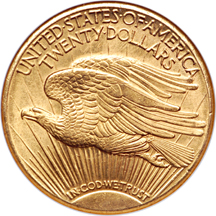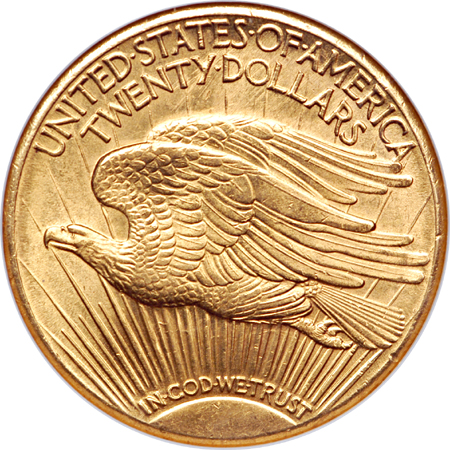|
|
The Midwest Winter Sale 2008
< Previous
Lot
1079
Next >
| Choose Category: |
|
|
|
|
|
|
|
Please Note: A 15% Buyers' Premium is added to the hammer price of all lots in this sale.
|
(About The Images)


|
|
Lot Title:
|
1925-S Saint-Gaudens double eagle, NGC MS-62
|
|
Description:
|
Official mintage figures for many coins can be deceiving as a factor for evaluating their rarity. Subsequent attrition, either at the hands of an abnormal circulation rate, excessively rapid deterioration from wear of the date area, widespread melting, or other means, can lead to serious depletion of the original production run, resulting in an issue whose rarity is far more acute than its relatively large mintage implies. There are numerous classic examples of this phenomenon in American numismatics, such as the 1884-S Morgan dollar, 1933 Indian eagle, and 1913-S Buffalo nickel, just to name a few. And the 1925-S Saint-Gaudens double-eagle certainly qualifies as another such enigma.
Any issue in the Saint-Gaudens series with a mintage of 3.8 million should be easily among the most common. But in the case of the 1925-S (as with other later San Francisco issues), virtually the entire original production was stored in Treasury vaults, and of the few that reached the hands of consumers, very few were set aside for future posterity. Those that were released to circulation actually were used, which explains why few extant examples remain in better mint state grades. Furthermore, during the 1930s, the huge piles of coins that were merely occupying space as they languished in the Treasury were doomed for the melting pot during the great melt-off of the 1930s.
Before proceeding with a description of this coin, let's briefly examine why so much gold currency was converted to liquid metal during the 1930s. At the time of the great depression, a Saint-Gaudens double-eagle really did represent its intrinsic value accurately; one coin of $20 face value contained just over $20 in gold bullion. In the spring of 1933, during the height of the Great Depression, as part of an emergency response to "Provide Relief in the Existing National Emergency in Banking and for other Purposes", Franklin D. Roosevelt announced the "Gold Surrender Order", which essentially required every American citizen to relinquish to the government all gold in his or her possession, including coins. Subsequently, the price of gold was artificially raised to $35.00 an ounce, which meant that the face value of the double-eagle was now greatly exceeded by its bullion value. This devaluation of the dollar was intended to make American exports cheaper to foreign trading partners, thus stimulating domestic economic growth. Because the gold coins were now obsolete and mostly in custody of the government, they were melted and converted into gold bars which could be stored and transported more conveniently than bags of coins. Therefore, for many issues, including the 1925-S, most uncirculated examples were actually held overseas, and not by U.S. collectors.
The example at hand is certified by NGC as grading MS-62, and by comparison to the many thousands of other coins (more common issues, that is) in identically graded holders, the assessed grade is exceptionally conservative. Typically, MS-61 and MS-62 are reserved for coins that, while technically lacking wear from circulation, tend to be rather generously handled and speckled with blemishes. Such is certainly not the case here. On the contrary, this coin exudes beautifully original mustard-gold surfaces that lack any real blemishes of significance. The small, shallow bag marks on Liberty's torso (which is where they usually appear first) are definitely minimal in number, and none is even casually significant. Because of the important lack of meaningful abrasions in the fields, this coin presents an admirable creamy-smooth texture the further exemplifies outstanding preservation. Finally, from a technical standpoint, the strike is about what would be expected from such a large original run, which to say the coin is nicely struck, but not fully so. On an individual note, this coin was struck with a reverse die that was heavily polished above the eagle's wing, resulting an interesting change in flow line texture in that area.
As collectors who were introduced to coins in the 1980s and 1990s advance to new challenges, the Saint-Gaudens series is one that has increased in favor and benefitted from the resurgent popularity of the coin collecting hobby in the last twenty-five years. Besides the challenge, there is of course the inimitable beauty of individual pieces, particularly in high grades. But the end result is the key - demand increases year after year, and the pressure to locate high grade examples of the better dates continually pushes their value upward. Therefore, this occasion to obtain one of the true key dates at a still-palatable price could prove fleeting, and this is especially true in light of just how nice this coin is. Opportunity knocks!
|
|
Low Estimate:
|
$14,000.00 |
|
High Estimate:
|
$18,000.00 |
|
Lot Status:
|
Bidding has been closed for this lot. |
|
Hammered Price: |
$17,000.00
|
|
Price Realized:
|
$19,550.00 |
|


Price history for items of the same classification:
| Lot # | Auction | Current Bid or Hammer Price | Description |
| 1057 | The Midwest Summer Sale 2012 on 07/27/2012 | $26,750.00 |
|
1925-S NGC MS-64.
|
|
Fifty-two coins comprise a complete set of Saint-Gaudens double-eagles (including the high-relief), and in the MS-64 grade, perhaps seven coins exceed the price-tag associated with 1925-S. Indeed,... |
|
| 872 | The Collectors' Auction 2009 on 10/16/2009 | $10,500.00 |
|
1925-S PCGS MS-62.
|
|
The Saint-Gaudens series sometimes seems fraught with enigma, since low-mintage issues might be considered plentiful, while high-mintage issues can prove downright uncommon. 1925-S is an example of... |
|
|
|
|